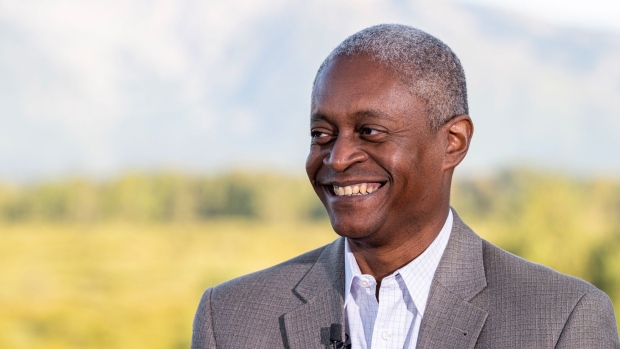Mar 2, 2023
Fed’s Bostic Open to Seeking Higher Rate Peak If Data Stays Hot
, Bloomberg News

(Bloomberg) -- Federal Reserve Bank of Atlanta President Raphael Bostic said he still prefers to raise rates by another quarter percentage point when officials meet later this month, but is mulling whether central bankers need to lift borrowing costs higher than the range of 5% to 5.25% he’s endorsed to defeat inflation.
“I let the data guide me,” Bostic told reporters in a press briefing. “If the data continue to come in suggesting the economy is stronger than I had projected, I’ll adjust my policy trajectory.”
Bostic, who isn’t a voter on monetary policy in 2023, earlier this week reiterated his call for the Fed’s key policy rate to be lifted to around 5.1% this year and then kept there until well into 2024. The Atlanta Fed chief acknowledged data have come in stronger and said he wasn’t prepared to adjust his formal estimate until going through a comprehensive pre-meeting review with his staff.
Make Case
‘’I want to be completely clear: There is a case to be made that we need to go higher,” Bostic said. “Jobs have come in stronger than we expected. Inflation is remaining stubborn at elevated levels. Consumer spending is strong. Labor markets remain quite tight.”
US central bankers are waging their most aggressive action against high inflation in a generation. Officials lifted their benchmark lending rate by a quarter of a percentage point at the start of February, bringing the target to a range of 4.5% to 4.75%. That was a step down from the half percentage-point increase at their December meeting, which followed four consecutive jumbo-sized 75 basis-point hikes.
Market expectations for the Fed peak rate have climbed to about 5.5% in September following indications of US economic strength, including an acceleration in employment growth in January and improvement in manufacturing, as well as higher inflation. Fed officials led by Chair Jerome Powell have predicted inflation will fall this year, while warning month-to-month changes will be bumpy.
Policymakers will meet again on March 21-22 where they are expected to raise rates by a quarter point, though a couple Fed officials have raised the possibility of a half-point move.
Bostic said smaller rate moves now make sense given that the effect of monetary policy on the economy is lagged, so the broader economy might be feeling the brunt of rate hikes only this spring.
Quarter-Point Camp
“Right now I’m still in a very firmly in the quarter-point move pacing,” Bostic said. “It is appropriate for us to be cautious and carefully calibrate to make sure that we don’t do more than we need to, but we do enough so that inflation gets to the 2% level.”
Bostic’s current suggested rate path estimate would call for two quarter-point moves in March and in May — though the Fed president suggested rate increases could well continue into the following meeting or two if the data continued to be strong.
Asked about when the Fed might pause rates, Bostic said, “I would expect that we could be in position by the middle of the summer, late summer. We’ll have to see sort of where things are.”
As the Federal Open Market Committee approaches a peak, that suggests the need for “slow and steady” pace, Bostic said.
“By going at a more measured pace, it reduces the likelihood that we’ll overshoot and lead to the hard outcomes that many are worried we’re going to trigger,” he said.
Bostic’s comments were echoed by Boston Fed President Susan Collins, who earlier urged some “additional rate increases and exactly what the right amount is really needs to be dependent on a holistic review of the information that we receive.”
(Updates with comment from Bostic in third paragraph.)
©2023 Bloomberg L.P.






